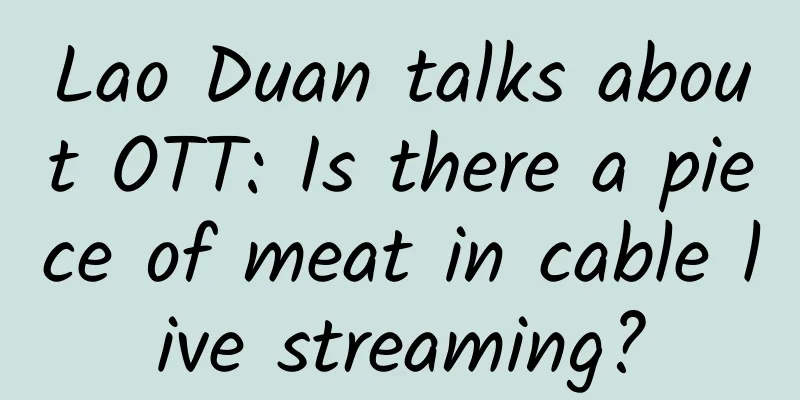Lao Duan talks about OTT: Is there a piece of meat in cable live streaming?

|
Integrating cable live broadcast at the terminal level has always been the dream of TV sets and set-top boxes. In 2013, with the launch of Hisense VIDAA, TCL iQiyi TV+, Xiaomi TV, and Skyworth Coocaa, the iceberg of live broadcast and on-demand integration, which has always been difficult to cross due to business, technology, and policy reasons, is being explored and melted little by little. Now everyone says that cable live broadcast is a piece of meat, but in fact, many Internet people and video people have been "vegetarian" for a long time! Cable TV has also been "badmouthed" for many years. But today, the Internet-based TV industry is turning around and re-examining and coveting this piece of meat. In fact, everyone is not thinking about doing live broadcasts themselves, but using the cable network as a ship to go out to sea and realize the control of the entrance and homepage of live broadcast programs in TV sets and set-top boxes. When integrating cable live broadcast content in TV sets, everyone is talking about user experience. In fact, for all manufacturers, commercial interests are the first, and user experience is always the second. Adam Smith gave a conclusion two or three hundred years ago. In many cases, user experience is just an excuse for commercial interests. To put it bluntly, everyone is fighting for entrances and platforms! Everyone takes it for granted that: the Internetization of computers has made Baidu, an entrance company, and the Internetization of mobile phones has made APPSTORE and Android Market, a platform. But I think that the Internetization of TV will neither make the entrance nor the platform. This is an industry where terminals are king, networks are king, and cloud is king. It is a typical "dumbbell model". The entrance of Internet TV is these oligopolistic TV manufacturers themselves, and the platform will only be those applications with the most normal distribution, mainly on-demand video websites and cable networks for live broadcasts. The applications on TV will not present a massive long-tail form. Terminals, cloud and networks, no one can integrate each other. Haha, if I continue, I will be criticized and spit on you! First, let’s analyze in detail the technical products and solutions for several TV sets that can integrate cable live broadcasting on the market: The first one is the SMIC solution, which is a machine-card separation mode based on the Shenzhen SMIC CAM card. This is the solution adopted by most domestic TV manufacturers and is also the national standard, but unfortunately cable operators do not like it. Because this solution only uses the cable network CA card for descrambling, other services including EPG, old data broadcasting, and novel cable network two-way services are blocked. Therefore, although various TV manufacturers have built-in slots for large cards in many TVs, very few users can actually install large cards. Because if you want to install a CA card, you must first negotiate business conditions with the cable in each province or even each city. It is definitely not as simple as purchasing the annual fee for cable TV. You must also add various so-called value-added services of the cable network. Therefore, Guowei, which tried its best to become the national standard, ended up with a failure to bloom. This CAM card sold very poorly in China, but it blossomed and bore fruit in Europe, and the company is preparing to go public on the Nasdaq in the United States. Essentially, the big card has given the cable network to OTT, because the TVs equipped with the big card have given the cable network to OTT and blocked all services except for the TS stream descrambled by CA. EPG advertisements and value-added services have nothing to do with the cable network. Based on this solution, TV manufacturers are making their own EPGs for cable channels across the country, but most of them are currently sourced from two or three third-party EPG channels on the Internet. The updates every Friday and the revisions on Monday are not only insufficient in quantity and low in quality, but also cannot compete with local cable networks. The CHINA-EPG of CCTV, which had great dreams in those days, has long been blown away by the wind and rain. Although EPG advertisements have gone through a difficult game with the advertising department of the local TV station (Radio and Television Group), they have now become the cash cow and profit cow of the cable network. Such a business is really a pity for cable networks. Data broadcasting, which was once highly anticipated, has fulfilled my old saying: "Digital TV has been around for many years, but it has not made any money today!" The second is Skyworth’s solution, which is Skyworth’s TV+STB model. Skyworth not only has strong TV sets, but also sells 25 million set-top boxes every year, making it the leader of domestic cable network DVB-C set-top boxes. Therefore, Skyworth first installed a set-top box motherboard with CA transplanted into the TV. Later, based on the cooperation of chip manufacturers such as MSTAR, it was simplified to only make a CA slot interface on the TV motherboard for descrambling, and all decoding and other work reused the TV chip. This is the lowest cost solution at present. It is difficult for other TV manufacturers to do it because their cable set-top box business is average. This solution needs to be transplanted with CA used by cable networks in various places, and it needs the cooperation of chip manufacturers. In addition, in order to gain the favor of cable networks in various places, it is also necessary to integrate with the business systems of cable networks in various places. This is a job that is not scary but exhausting. Many years ago, foreign OPENTV and domestic middleware companies that were committed to horizontalizing the technical part of this business, how are you doing now? In recent years, we have rarely heard of them. Based on the above resources and efforts, Skyworth's all-in-one cable TV is the best-selling among all TV manufacturers, with sales this year ranging from 1.5 to 2 million units, which is a considerable number compared with the domestic annual sales of 8 million units. This should be due to the integration of TVs and set-top boxes within the Skyworth Group. Another similar innovation is TCL iQiyi TV, which makes its remote control dual-mode, and can control the TV and set-top box at the same time through buttons and voice. That is to say, on the TV interface, you can see the current programs of each cable channel. If you click in (you can also say "Hunan Satellite TV, CCTV5, etc." by voice), the TV will directly switch to the HDMI or standard-definition input signal source connected to the set-top box. At this time, you can use this remote control to control the set-top box, change channels, adjust the volume, and watch the EPG of the cable network. This method does not require any cooperation with the cable network. You only need to set the geographical location and set-top box model when setting up the TV. The common point of these two solutions is that they both conform to the business model and commercial interests of the cable network. I will not touch your cheese. I just do my job as a terminal manufacturer. The so-called user experience is just to do a good job. The third is the Yongxin solution, which is Yongxin Tongfang’s CA separation model. Yongxin has been using this model for a long time, but it has only really landed on Xiaomi TV. This is a dedicated CA descrambling module, and it also looks like a small box. It only does descrambling, and the rest of the work still needs to be processed by the TV chip. So what is the difference between this solution and the previous two solutions? Why do we do this? Haha, the reason lies in the main chip, because Xiaomi uses Qualcomm chips, which are all made for mobile phones, so these chips are not good at and have no experience in processing modules related to TV, especially cable TV. Therefore, these modules need to be taken out separately to make a small box, and then the video stream is input into the TV through USB. As a CA manufacturer, Yongxin has been considering breakthroughs in business models, and these TVs, especially cable TV, are what Yongxin is very good at. Yongxin's CA currently has half of the stock market. Of course, Digital Video has been catching up and doing well. The advantage of this model is that it provides a short, flat and fast solution for the interaction between cable live broadcast and network on-demand when non-TV chips (except MSTAR, MediaTek, etc.) are used for TV. Its technical principle is similar to Guowei's large card solution, but because it is a solution made by CA manufacturer Yongxin, it should not have been transplanted to other CAs, so it can only be used in Yongxin's CA coverage area. However, since Xiaomi is a major profit and tax contributor in Haidian District and even Beijing, it may be able to persuade Gehua from the government level to open its cable TV to Xiaomi TV, and it is also possible that Xiaomi will control EPG. The byproduct of this model is that it is possible to bring Yongxin CA into Gehua. Haha, Yongxin CA and Digital CA are using two different ways to enter Gehua. It is still unclear whether it will win or lose or win-win. This method, because the technology and card are similar, so the model is the same, but it uses the live streaming of the cable network, and EPG and other operations are out of the control of the cable network. This is definitely opposed by the cable network. Based on this, there are people on the Internet who are discussing that Xiaomi TV wants to defeat the cable network to become a virtual operator. Haha, whether Xiaomi thinks so or not, the cable network must think so. Of course, in the future game, it is possible to reach a consistent interface between the two parties in the control of EPG and even the TV homepage and live broadcast entrance. In this way, Xiaomi may have a perfect cooperation with the cable network. When IPTV was still in the game with OTT, the cable network was still considering how to do DVB+OTT, but it accidentally ran into OTT+DVB. I don’t know the details, but I can guess that the cable network EPG information of Xiaomi TV is provided by Yongxin. Yongxin, which does CA, is the same as Skyworth, which does set-top boxes. They have the strongest ability to obtain EPG information of cable networks in various places, surpassing small companies on the Internet and companies such as Huanwang and Hisense. There is another solution, which is soft CA, a downloadable CA. This is the lowest-cost solution, and it is also a system and product with latecomer advantages in technology. Because this solution is promoted by the Science and Technology Department of the State Administration of Radio, Film and Television, its influence and persuasiveness on the cable network is much stronger than that of the Ministry of Industry and Information Technology, which promotes the separation of machine and card. However, it has not yet been commercialized on a large scale, so it is not within the scope of today's specific discussion. The differences between the above three solutions from the perspective of the cable network are: First, Whether the terminal sales can be profitable. No one thinks that the sales revenue of TV sets should be shared with the cable network, but the control of set-top boxes is 100% in the hands of the cable network. Therefore, the cable network will have two kinds of thinking. The first is that this kind of TV set affects the terminal revenue of the set-top box of the cable network, so it should be opposed. The second is that this kind of TV set saves the cost of a set-top box for the cable network and users, so it should be supported. In fact, these two kinds of thinking are not contradictory, and this contradiction is not a big contradiction. It is easy to reach a consensus on any quantifiable benefits. second, Who controls the live channel entrance, interface and EPG on the TV? This is the key. As a monopoly cable TV operator, Cable Network will never be willing to give up control of these things to others. Because compared with the above-mentioned quantifiable benefits, this control represents future benefits, which are neither easy to quantify nor easy to discount. In addition, it involves control rights, and issues like sovereignty cannot be negotiated. From the above analysis, it seems that the cable network has absolute control and decision-making power. The cable network will support the second option and oppose the first and third options, making it impossible for them to develop and being strangled in the cradle. But this is not the case, because at present, at least 70% of the cable network users in the country have not done machine card binding. Only a few foreign early CAs such as NDS and CANAL+ have done machine card binding. Therefore, now regardless of whether the cable network agrees or not, these three options can do one thing in the area where CA and set-top boxes in the cable network have not been bound to machine cards, that is, users take out the CA card in the original set-top box and insert it into the TV. This has given many terminal manufacturers an opportunity, so they are trying their best to integrate cable live broadcasts, at least to integrate the entrance and homepage, and to go a little deeper to interact and recommend live broadcasts and on-demand broadcasts. The ultimate goal is to have one cloud, multiple screens, and social TV. But I don't think it's that simple. Cable networks are basic network resources, and so far I can't see any better alternatives for live broadcast channels, not to mention factors such as policies, supervision, and protection of state-owned assets. DVB+OTT is the best combination. There is no substitute for it in terms of technical products, cost-effectiveness, or even compliance with national policies. Therefore, neither the terminal nor the cable network can integrate with each other, just like video websites and terminals in OTT cannot integrate with each other. No one can create a Baidu-like portal and platform in front of the cable network's live broadcast! Do you think the cable network is a sick cat? The assets and future related to live broadcast will definitely be controlled by the cable network, including the homepage and EPG. Why do we always think about integration and defeating others first? Why can't we cooperate well? Are Chinese people not good at cooperation? I think cooperation is the best strategy for both Internet TV and the integration of live broadcast and on-demand. The reason is simple, because Internet TV is not a complete revolution from carriage to car, but just an integrated innovation and model innovation. I think there will be a day when cable networks gradually abandon VOD, embrace OTT and join the win-win cooperation model of DVB+OTT. The cooperation of cable networks + video websites (including licensees) + terminals will bring users and viewers better interactive enjoyment of live broadcast + on-demand, realize the seamless interaction of mobile phones and TVs as "mutual accessories", realize one person with multiple screens instead of one cloud with multiple screens, and realize the two most important industrial concepts of "making TV better" and "making the industry healthier"! This is my career dream of Internet TV. I think that although there are difficulties, it should not be far away. Friends of Cable TV, familiar or unfamiliar, I'm waiting for you on iQIYI! As a winner of Toutiao's Qingyun Plan and Baijiahao's Bai+ Plan, the 2019 Baidu Digital Author of the Year, the Baijiahao's Most Popular Author in the Technology Field, the 2019 Sogou Technology and Culture Author, and the 2021 Baijiahao Quarterly Influential Creator, he has won many awards, including the 2013 Sohu Best Industry Media Person, the 2015 China New Media Entrepreneurship Competition Beijing Third Place, the 2015 Guangmang Experience Award, the 2015 China New Media Entrepreneurship Competition Finals Third Place, and the 2018 Baidu Dynamic Annual Powerful Celebrity. |
<<: TCL re-starts color technology revolution; 2015 CES may become a watershed for the TV industry
>>: Lao Duan talks about OTT: How does Internet TV make money?
Recommend
The operation logic of Douyin Enterprise Account!
From the internet-famous Haidilao dipping sauce, ...
Lao Luo Weibo 1799: The double-edged sword effect of excessive marketing
Because of jet lag and insomnia, I checked Weibo ...
Jiuquan WeChat ordering software mini program, how much does the WeChat mini program for ordering food cost?
Everyone is familiar with WeChat mini-programs . ...
If the earth stopped rotating, where could we survive?
Produced by | Science Popularization China Author...
The complete secrets of SEO promotion revealed, only here!
The road ahead is long and arduous, but I will co...
Practical review: How to build a complete operation system?
This article is a review of my recent practice. T...
Benxi SEO training: Develop SEO periodic optimization procedures to effectively help companies measure optimization results
There will be a travel plan or vacation plan for ...
24 tips for stranger social networking. What needs does stranger social networking solve?
Training Outline Opening remarks: Five modules to...
Android-menudrawer-master open source powerful sidebar menu
Source code introduction There are different styl...
Indonesia is short of milk, so it uses "fish milk" to feed its children. When can fish produce milk?
Image source: Internet Indonesia is trying out an...
Two Audi 4S stores in Beijing and Zhengzhou have successively switched to Wenjie, and BBA's offline base has begun to shake
The competition in the automotive industry is far...
There is no duck in the duck blood for hot pot? 15 types of duck blood were tested, and the results were unexpected!
After testing the authenticity of mutton skewers ...
How to seize the golden 6 seconds of video advertising? Video advertising tips!
Information flow advertising has entered the seco...
These "forest giants" wearing "golden armor" are actually the "living map" of the Jiangnan forests
In early February, a friend sent me a photo of a ...
Xigua Video product analysis report!
As a product of Toutiao, Xigua Video has been aro...









